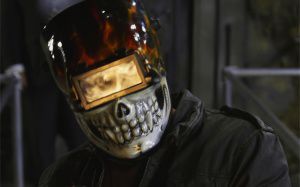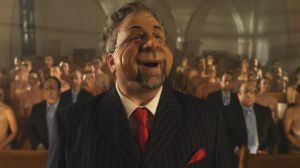As of late, it has become a rather irksome tendency of trailer editors and review writers alike to include an inappropriate over-abundance of major plot points in their works, and often times unintentionally ruin the very story they intended to promote. One can only do his best, however, over the duration of a review, to not spoil the ending of the great film that is John Dies at the End.

The latest brainchild of director Don Coscarelli (Phantasm, Bubba Ho-Tep), John Dies at the End follows the story of John and Dave, a pair of college dropouts who, while attending a late-night rock n’ roll rave, are inadvertently dealt an inter-dimensional, host-choosing drug known as “Soy Sauce.” Once injected, Soy Sauce allows both John and Dave to break free of their realm and experience the hypothetical possibilities of every other, which usually come in the form of giant, creepy insects or a walking, talking monster comprised entirely of meat.
What thus ensues is a story so deliciously disgusting, so horrifically hilarious, that it leaves viewers with the sense that they have just watched a film for the ages — one that, in due time, might contract its very own cult following. Amidst bratwurst cell phones, intestine-devouring slugs, and doorknobs that transform into male genitalia, John Dies at the End provides us with a rare gem of a story archetype that is too often overlooked as something “vague,” or even “too artistically inclined.”
What perhaps drives the film’s ever-imminent strengths is the story’s original form as an online amateur novella, originally crafted by the Senior Editor for cracked.com, David Wong. Whatever “cult-ness” the film portrays is simply an accentuated continuation of its initial cult following as a written piece: each blessed moment of eccentricity allows an immersion not unlike those from the original story, as does each spectacle of nail-biting horror and blissfully potent awe.
Having read the book, one might offer the opinion that the film includes a bare minimum of content, and refuses to delve into any detail past the true heart of the story. However, what ultimately allows the film to shine is its exceptional ability to utilize every ounce of pure story it has to work with, and it never once drones on into any sort of unwelcome detail that might prove confusing or unnecessary.

What Coscarelli has given his audience is an excellent film reminiscent of past works, in that it poses one puzzling riddle after another: from the opening sequence inquiring whether or not a broken axe has severed the reanimated head of a dead man, to the intelligibly facile “What is real?” The film itself is essentially one large oxymoron — an honest play on the imaginarily real that consistently challenges the viewer to see the world from a different angle. The brilliance of John Dies at the End is simply accentuated by each obscure oddity it displays, and leaves the viewer with a refreshing sense of bewilderment, ready to challenge the very fabric of our world.






